Breaking SWFL Art News July 15-21, 2014
A Shout Out and Thanks to Our Sponsors:
- Marcus Jansen and UNIT A Contemporary Art Space
- Leoma Lovegrove and Lovegrove Gallery & Gardens
- Edison & Ford Winter Estates
- The Miville Gallery and Franklin Shops on First
- True Tours
- Hot Works, LLC and the Estero Fine Art Show
IN THIS SECTION OF ART SOUTHWEST FLORIDA, YOU WILL FIND THE LATEST “BREAKING” NEWS FROM THE SOUTHWEST FLORIDA ART SCENE
Monumental sculptor Harry McDaniel’s ‘Beacons’ now profiled on Art Southwest Florida (07-21-14)
Beacons consists of three 10-foot-high by 4-foot-wide brushed aluminum kinetic sculptures created by metal sculptor Harry McDaniel. Enabled by stainless steel ball bearings, the tops have “branches that spin in the wind.” According to the artist, the tapering upright forms of each piece are suggestive of the lighthouses that can be seen in various places along the west coast of Florida. As the top sections move in the wind, they reflect light in all directions as do the “beacons” of a lighthouse.
![]() The grouping is located in a landscaped area near the drop-off entry circle/overhang area of Sugden Hall that is similar to a drop-off area that is found at a resort.
The grouping is located in a landscaped area near the drop-off entry circle/overhang area of Sugden Hall that is similar to a drop-off area that is found at a resort.
Beacons is part of the Florida Art in Public Buildings program, an initiative started in 1979 pursuant to section 255.043 of the Florida Statutes, which earmarks 0ne-half of one percent of the amount the legislature appropriates for the construction of state buildings for the acquisition of public artworks. It was installed in 2012 at a cost of $20,650.
To read about the sculptor and the three Gulf Coast lighthouses, please click here.
____________________________________________________
On this day in 1955, Evelyn D. Rea signed a will giving ‘Lorelei’ to the Public Library of Fort Myers (07-20-14)
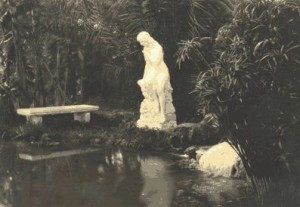 On this day in 1955, Evelyn D. Rea signed her Last Will and Testament. The document contained a provision that bequeathed her 1880 white marble sculpture known as Lorelei to the Public Library of Fort Myers. Rea died in 1959 and the library took possession of the German siren in 1960 after the period for creditors to file their claims against the estate had expired.
On this day in 1955, Evelyn D. Rea signed her Last Will and Testament. The document contained a provision that bequeathed her 1880 white marble sculpture known as Lorelei to the Public Library of Fort Myers. Rea died in 1959 and the library took possession of the German siren in 1960 after the period for creditors to file their claims against the estate had expired.
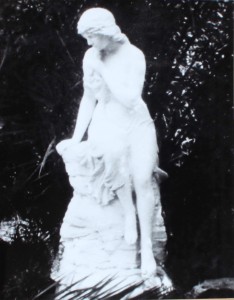 According to Fort Myers resident James Butler, the statue languished in storage at the library until in 1961. “I asked to borrow it to use at our senior prom at the Exhibition Hall. There was so much dirt and dust on the piece that it was muddy grey. We cleaned it and used it for the centerpiece of the dance,” the theme of which was the Gardens of Elysium (which in Greek mythology was the final resting place of the heroic and the virtuous). “When it was returned to the library, the staff was impressed by the newly cleaned marble and had it placed in front of the building.”
According to Fort Myers resident James Butler, the statue languished in storage at the library until in 1961. “I asked to borrow it to use at our senior prom at the Exhibition Hall. There was so much dirt and dust on the piece that it was muddy grey. We cleaned it and used it for the centerpiece of the dance,” the theme of which was the Gardens of Elysium (which in Greek mythology was the final resting place of the heroic and the virtuous). “When it was returned to the library, the staff was impressed by the newly cleaned marble and had it placed in front of the building.”
It graced the library’s entry from that time until the night of 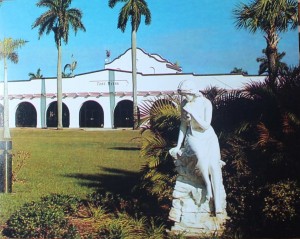 October 29, 1997, when one or more vandals knocked off her head along with a piece of one arm and some toes. The culprit(s) were never caught and the head has never been recovered. “I was hoping when they cut away all the bushes and brambles, then they’d find the head,” said Sally Jane, who was the reference librarian at the time. “We never knew who did it. It wasn’t like they left a note saying, ‘I got your head.’ It just disappeared.”
October 29, 1997, when one or more vandals knocked off her head along with a piece of one arm and some toes. The culprit(s) were never caught and the head has never been recovered. “I was hoping when they cut away all the bushes and brambles, then they’d find the head,” said Sally Jane, who was the reference librarian at the time. “We never knew who did it. It wasn’t like they left a note saying, ‘I got your head.’ It just disappeared.”
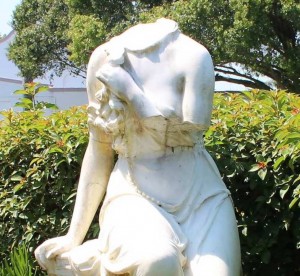 The library wrapped the damaged statue in plastic and tape while they contemplated what to do. The damaged Lorelei caused a rift among library personnel. “We had a great debate about whether to remove it or try to repair it, and repairing it was problematical,” recalls Jane. Meanwhile, people sent indignant letters to the News-Press Mailbag. Raul Jordan of Fort Myers wrote, for example: “With sadness I noticed that the statue rests on its pedestal armless and headless only in a grotesque pile of worthless stone. Two thoughts come to my mind: Either mystically we believe that the wicked goddess taken away from the green-blue waters of the Mediterranean chanted herself to self-destruction; or that our city fathers do not show appreciation for valuable art and simply do not give a ‘siren’ about it.”
The library wrapped the damaged statue in plastic and tape while they contemplated what to do. The damaged Lorelei caused a rift among library personnel. “We had a great debate about whether to remove it or try to repair it, and repairing it was problematical,” recalls Jane. Meanwhile, people sent indignant letters to the News-Press Mailbag. Raul Jordan of Fort Myers wrote, for example: “With sadness I noticed that the statue rests on its pedestal armless and headless only in a grotesque pile of worthless stone. Two thoughts come to my mind: Either mystically we believe that the wicked goddess taken away from the green-blue waters of the Mediterranean chanted herself to self-destruction; or that our city fathers do not show appreciation for valuable art and simply do not give a ‘siren’ about it.”
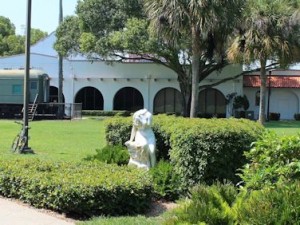 In the end, the library removed the packing and left the enchantress to languish headless outside their front entrance. In truth, the technology to restore the sculpture did not exist back then. It was only in 1999 that researchers at Florida Atlantic University developed computer algorithms that now make it possible to fabricate a new head, elbow and toes for decapitated siren using historic photographs of the sculpture as it looked in 1930 when Ms. Rea brought her to Fort Myers. Even so, conservators Rosa Lowinger and Lauren Hall don’t think a new head, elbow or toes should be fabricated for the sculpture.
In the end, the library removed the packing and left the enchantress to languish headless outside their front entrance. In truth, the technology to restore the sculpture did not exist back then. It was only in 1999 that researchers at Florida Atlantic University developed computer algorithms that now make it possible to fabricate a new head, elbow and toes for decapitated siren using historic photographs of the sculpture as it looked in 1930 when Ms. Rea brought her to Fort Myers. Even so, conservators Rosa Lowinger and Lauren Hall don’t think a new head, elbow or toes should be fabricated for the sculpture.
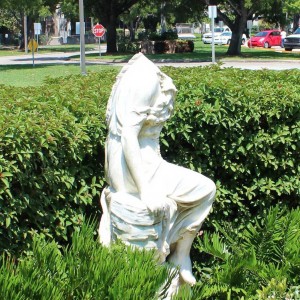 “From a conservation standpoint, these elements can be recreated; however it is [our] opinion that the piece could be equally exhibited without those portions added,” state conservationists Rosa Lowinger and Lauren Hall in a May 15, 2013 conservation report commissioned by the Fort Myers Public Art Committee. “It is possible to refabricate elements that could be put in place to simulate the original components. It is our opinion, however, that the extensive invention, cost, and simulacra that this would constitute would leave the piece heavily restored.”
“From a conservation standpoint, these elements can be recreated; however it is [our] opinion that the piece could be equally exhibited without those portions added,” state conservationists Rosa Lowinger and Lauren Hall in a May 15, 2013 conservation report commissioned by the Fort Myers Public Art Committee. “It is possible to refabricate elements that could be put in place to simulate the original components. It is our opinion, however, that the extensive invention, cost, and simulacra that this would constitute would leave the piece heavily restored.”
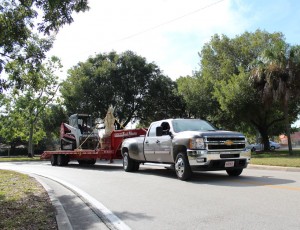 Lorelei was relocated to the Fort Myers Lee County Garden Council on January 6, 2014, with the firm of Flint & Doyle digging up Lorelei and transporting her gratis to her new home in the Berne Davis Garden at the Fort Myers-Lee County Garden Council. “We are over-the-top excited to bring her here,” said Second Vice-President Sandy Kavouras as the statue was being placed by Flint & Doyle in the Hibiscus Garden next to the front entry. “It feels like she’s finally coming home.”
Lorelei was relocated to the Fort Myers Lee County Garden Council on January 6, 2014, with the firm of Flint & Doyle digging up Lorelei and transporting her gratis to her new home in the Berne Davis Garden at the Fort Myers-Lee County Garden Council. “We are over-the-top excited to bring her here,” said Second Vice-President Sandy Kavouras as the statue was being placed by Flint & Doyle in the Hibiscus Garden next to the front entry. “It feels like she’s finally coming home.”
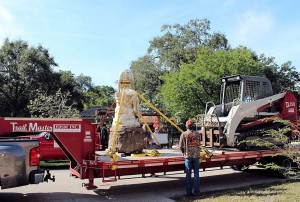 Kavouras is referring to the fact that Rea was a member of the Periwinkle Garden Club, which was one of nine garden clubs that banded together in 1957 to form the Garden Council. Today, the Periwinkle is one of twenty member garden clubs, eight plant societies and two affiliates that comprise the Garden Council, which represents more than 1,800 individual members throughout Southwest Florida.
Kavouras is referring to the fact that Rea was a member of the Periwinkle Garden Club, which was one of nine garden clubs that banded together in 1957 to form the Garden Council. Today, the Periwinkle is one of twenty member garden clubs, eight plant societies and two affiliates that comprise the Garden Council, which represents more than 1,800 individual members throughout Southwest Florida.
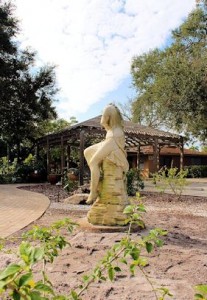 The Council, which occupies its location of Virginia under a long-term 2007 lease from the City of Fort Myers, has undertaken Lorelei’s conservation and care. This will initially involve cleaning the marble to remove dirt, grime and soluble salts and applying a fungicide to help mitigate staining from fungus and mold. After that, injection and other repair methods will be required to stabilize the marble, which is flaking and spalling as a result of more than 50 years of exposure to direct sunlight, wind and rain. Ultimately, the Garden Club will cover Lorelei with a gazebo or other structure to eliminate or mitigate UV and other environmental factors that threaten to damage the delicate marble in the future.
The Council, which occupies its location of Virginia under a long-term 2007 lease from the City of Fort Myers, has undertaken Lorelei’s conservation and care. This will initially involve cleaning the marble to remove dirt, grime and soluble salts and applying a fungicide to help mitigate staining from fungus and mold. After that, injection and other repair methods will be required to stabilize the marble, which is flaking and spalling as a result of more than 50 years of exposure to direct sunlight, wind and rain. Ultimately, the Garden Club will cover Lorelei with a gazebo or other structure to eliminate or mitigate UV and other environmental factors that threaten to damage the delicate marble in the future.
You can see Lorelei in her new home on Tuesday mornings or by appointment by contacting the Fort Myers Lee County Garden Council
______________________________________________________________














 Tom Hall is both an amateur artist and aspiring novelist who writes art quest thrillers. He is in the final stages of completing his debut novel titled "Art Detective," a story that fictionalizes the discovery of the fabled billion-dollar Impressionist collection of Parisian art dealer Josse Bernheim-Jeune, thought by many to have perished during World War II when the collection's hiding place, Castle de Rastignac in southern France, was destroyed by the Wehrmacht in reprisal for attacks made by members of the Resistance operating in the area. A former tax attorney, Tom holds a bachelor's degree as well as both a juris doctorate and masters of laws in taxation from the University of Florida. Tom lives in Estero, Florida with his fiancee, Connie, and their four cats.
Tom Hall is both an amateur artist and aspiring novelist who writes art quest thrillers. He is in the final stages of completing his debut novel titled "Art Detective," a story that fictionalizes the discovery of the fabled billion-dollar Impressionist collection of Parisian art dealer Josse Bernheim-Jeune, thought by many to have perished during World War II when the collection's hiding place, Castle de Rastignac in southern France, was destroyed by the Wehrmacht in reprisal for attacks made by members of the Resistance operating in the area. A former tax attorney, Tom holds a bachelor's degree as well as both a juris doctorate and masters of laws in taxation from the University of Florida. Tom lives in Estero, Florida with his fiancee, Connie, and their four cats.